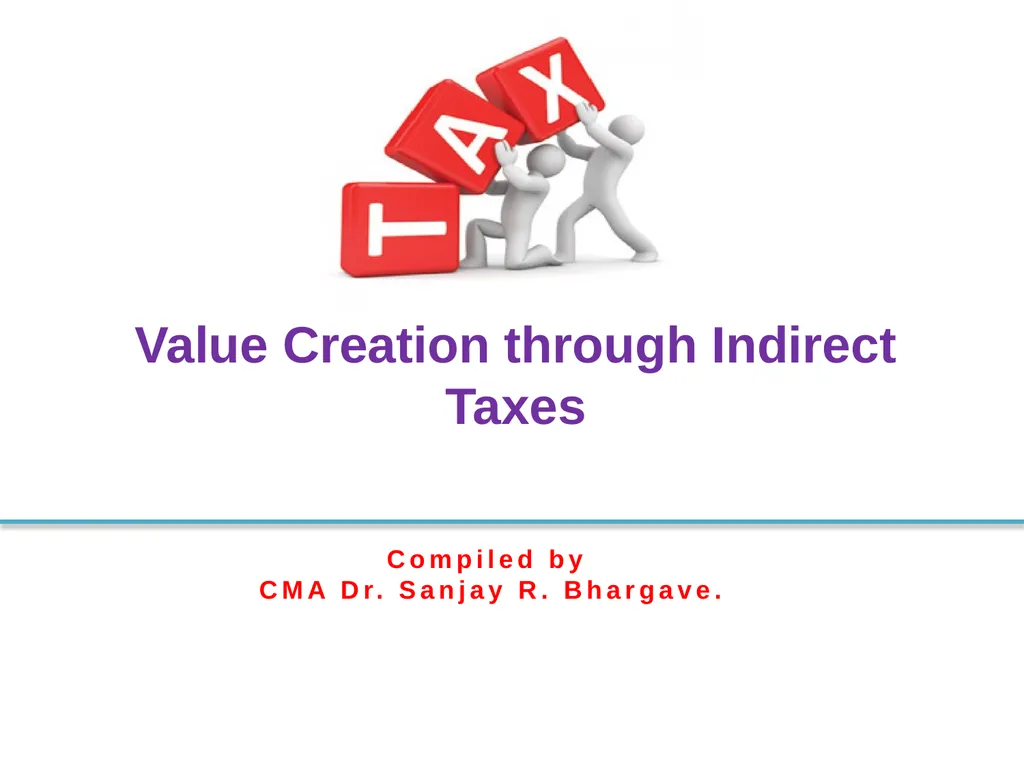Compiled by CMA Dr. Sanjay R. Bhargave. Value
Author : lois-ondreau | Published Date : 2025-06-23
Description: Compiled by CMA Dr Sanjay R Bhargave Value Creation through Indirect Taxes Post GST Tax Structure in India Direct Taxes Income Tax Corporate Tax Wealth Tax Indirect Taxes Customs Duty GST Foreign Trade Policy CMA Dr Sanjay R Bhargave
Presentation Embed Code
Download Presentation
Download
Presentation The PPT/PDF document
"Compiled by CMA Dr. Sanjay R. Bhargave. Value" is the property of its rightful owner.
Permission is granted to download and print the materials on this website for personal, non-commercial use only,
and to display it on your personal computer provided you do not modify the materials and that you retain all
copyright notices contained in the materials. By downloading content from our website, you accept the terms of
this agreement.
Transcript:Compiled by CMA Dr. Sanjay R. Bhargave. Value:
Compiled by CMA Dr. Sanjay R. Bhargave. Value Creation through Indirect Taxes Post GST - Tax Structure in India Direct Taxes Income Tax Corporate Tax Wealth Tax Indirect Taxes Customs Duty GST Foreign Trade Policy CMA Dr. Sanjay R. Bhargave Major defects in earlier structure of Indirect Taxes India did not have a national market due to invisible barriers of Central Sales Tax, Entry Tax and State Vat and visible barriers of check posts. Central Sales Tax (CST) was payable @ 2% for every movement of goods from one State to other. Stock transfers or branch transfers were taxable, however set off was not available fully. Cascading effect of taxes could not be avoided due to multiplicity of taxes. VAT and CST was payable on Central Excise element also. Movement of goods from one State to other was not tax free due to entry tax. CMA Dr. Sanjay R. Bhargave Millions of man-hours and truck hours were lost at check posts. Besides, huge corruption was involved. Central Government could not impose tax on goods beyond manufacturing level. State Government could not impose Service Tax. Conflict between goods or services- Twice levy of taxes on same transaction. Same transaction was taxed both by Central and State Government which created confusion, litigation and double taxation in many cases. Variations in VAT rates, forms and procedures among the states. Major defects in earlier structure of Indirect Taxes CMA Dr. Sanjay R. Bhargave Object of GST To overcome the defects in Taxation System and following the worldwide trend of Goods and Service Tax (GST), the Government of India also, as a part of Tax Reform process , moved to GST on 1st July 2017. It is a very bold and progressive step taken by the Government. As per Statement of Objects and Reasons appended to One Hundred and First Constitution Amendment Bill, the object of GST is (a) to have common market, and (b) avoid cascading effect of taxes. CMA Dr. Sanjay R. Bhargave Taxes subsumed in GST Central Taxes Central Excise Duty, Additional Excise Duties on Goods of special importance, Textile CVD, SAD Excise Duty levied under the Medicinal and Toilet preparations (Excise Duties) Act, 1955. Service Tax, Central Surcharges and Cesses on Excise/Service tax States Taxes State VAT/Sales Tax, Purchase Tax Entertainment tax (unless it is levied by the local bodies), Central Sales tax (levied by Centre and collected by States) Octroi














